The Land Of China -- Explore by Province
Xinjiang
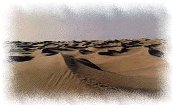 Desert
Desert
|
Xinjiang is a large region in northwest China that covers one-sixth of China's land. It consists of two basins that are surrounded by mountains on three sides. The Jungarian Basin lies south of the Altai mountains and north of the Tian Shan (Heavenly Mountains). This latter range in turn provides the northern and western boundaries for the massive Tarim Basin, most of which is covered by the Taklimakan Desert. This basin is bounded to the southeast by the Pamir and Karakoram ranges and to the southwest by the Himalayas. The Taklimakan stretches into the western reaches of the Gobi desert to the east.
Xinjiang is a Uygur Autonomous Region, and its attractions are its people and scenery. Nationalities living in Xinjiang love dancing, singing, and playing their own unique musical instruments.
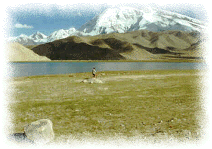 a Solitary Traveller
a Solitary Traveller
|
They are hospitable people, and visitors are invited to taste sweet grapes, melons, and plums, drink tea, and join the lively dancing.
The area has long played a key role in Asian history, although it is a little known part of the world. Its location in the middle of the Asian continent has resulted in a succession of conquerors and traders passing through the area over the last two millennia. For much of that time, it has lain within the Chinese sphere of influence. However, since the expansion of the Czarist Empire into Central Asia in the nineteenth century, it has become one of a number of areas in Asia where the Chinese and the Russians have competed for the allegiance of the local inhabitants.
 a Scene
a Scene
|
Capital city, Urumqi, is 4000 km away from Beijing. The Beijing-Urumqi express is China's longest train ride. Xinjiang Museum has a collection of historical relics of the various nationalities living in the region, and its exhibits include Roman and Persian coins and other relics of the Silk Road. At Bazaar, visitors can buy handicrafts, taste pancakes and shish-kebabs.
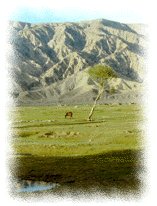 the Nanshan Pasture
the Nanshan Pasture
|
About 65 kilometers south of Urumqi is the Nanshan Pasture. Here, there are mountains, valleys, fountains, waterfalls, cypress, and pine trees. It is an exciting experience for tourists as they ride horses and climb mountains in the fresh air during the day while they stay in a yurt eating barbecued mutton during the evening.
 the Xinjiang Exhibition Hall
the Xinjiang Exhibition Hall
|
The Xinjiang Exhibition Hall opened in 1953 and is situated in the Xinjiang Autonomous Region Museum in Urumqi. Displayed at the hall are pictures, life-like models and artifacts of architecture, production tools, costumes, daily necessities and stationary. This introduces the people, customs, ways of life and traditional cultures of 12 minority nationalities in Xinjiang such as the Uygur, Kazak, Mongolian, Kirgis, Hui, Tajik, Tatar, Ozbek, and the Russian.
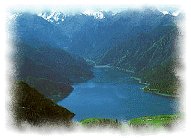 Lake Tianchi
Lake Tianchi
|
Tianshan (Heavenly Mountains) and Lake Tianchi (Heavenly Lake) are 115 kilometers from Urumqi. The southern slopes of the Tianshan have plenty of sunshine and water to make it a heaven of carpets of green grasses and bright wild flowers. Imagine riding a handsome horse through knee-deep flowers and grasses! The Heavenly Lake, at 1,980 meters elevation half way up on Mount Bogda in Fukang County, is 3,400 meters long, 1,500 meters wide and 105 meters in depth at its deepest spot. Its total area is 4.9 square kilometers. The white snow on top of Mount Bogda and the green water of the lake form beautiful scenery, making it not only a summer resort but an ideal alpine arena.
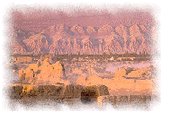 the Flaming Mountains
the Flaming Mountains
|
The Flaming Mountains stand in the north of the Turpan Basin and is 100 km long, 10 km wide and 500 meters above sea level. Composed mainly of red sandstone, the mountains look like raging flames in the blazing sun which gives them the name 'The Flaming Mountains'. In midsummer, the temperature waves may reach 800 Degrees Celsius. The mountains featured in the tales of "The Monkey King Passing the Flaming Mountains" and his battle with Princess Iron Fan in "The Pilgrimage to the West" by Wu Cheng'en of the Ming Dynasty.
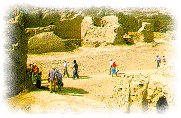 the Ancient City of Gaochang
the Ancient City of Gaochang
|
Situated at the foot of the Flaming Mountains, The Ancient City of Gaochang was founded in the first century B.C. and abandoned by the end of 13th century. It consists of three parts: the Inner City, the Outer City and the Palace
City, with an area of two million square meters of rammed earth. The outer city wall is 5-4 kilometers long. Remains of a temple can be seen in its southwest and southeast corners. In the middle of the outer city is the inner city, which is 3 km in circumference. There is a high terrace with a 15-meter-high structure called "Khan's Castle". The rectangular Palace City is in the north, the rammed earth foundation are the ruins of the old palace buildings
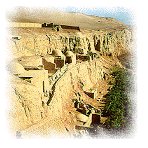 the Bizaklik Caves
the Bizaklik Caves
|
The Bizaklik Thousand-Buddha Caves are situated on the cliffs of Mutougou Valley east of Turpan. During the 6th to 13th century, the caves were a Buddhist center. There are a total of 77 caves, 40 of which have murals including stories from "Buddhacari-takavysutra" and Mourning Buddhist Monks and Sakyamuni's disciples from "Nirvana", which are excellent works of rare art.
The Tumuli, known as "The Underground Museum", is located southeast of Turpan and north of the ancient Gaochang City. They are scattered over a 10 square kilometer area. Buried there are both officials and common people of the Cheshi, Hun and mainly the Han nationalities. About 1,000-year-old mummified corpses have been unearthed from more than 500 tombs and excavations have yielded thousands of precious relics.
The Grape Valley lies on the west side of the Flaming Mountains. It is eight kilometers long and half a kilometer wide. It is extremely hot during the summer in Turpan, especially on the Flaming Mountains. But it is pleasantly cool and humid in the valley with its criss-cross irrigation channels and many leafy trees. The valley abounds in grapes, the most famous being the Seedless White, Manaizi, and Rosy. The acreage under grape cultivation totals 220 hectares but also contains peaches, apricots, apples, pomegranates, pears, watermelons and musk melons.



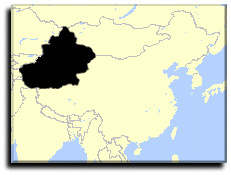













 Chinese Culture
Chinese Culture